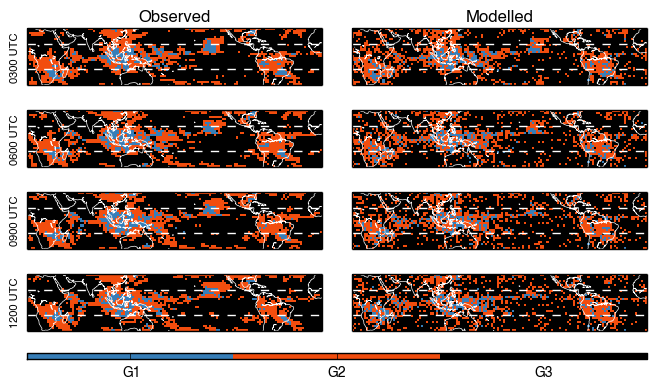Main Page
About Me
Research
Links
Contacts
| Introduction | Regime Properties | IR-Only Regimes | Statistical Model | GCM Evaluation | Precipitation Changes | References |
|---|
Statistical Models of Cloud Regimes
This section provides a brief outline of my work into the spatiotemporal coherence of tropical convection in the observation and in statistical models. This is still work in progress.
 |
| Figure 1: Snapshots at different timesteps of the regime field in a statistical model. |
In global-scale climate models, convection within a grid box cannot be resolved and thus have to be represented through convective parametrisation schemes. Most schemes, however, are diagnostic and deterministic. 'Diagnostic' means that convection in a grid box is a function of the large-scale variables within that grid box only, without any time memory or spatial coherence explicitly encoded. It is assumed that coherence in convection is achieved through the coherence in large-scale variables. 'Deterministic' means a one-to-one relationship between convection and the large-scale variables.
Our analysis into the properties of tropical convection suggests that, at the scales typical of global climate models, the relationship between convection and large-scale variables has a stochastic element to it, as opposed to being purely-deterministic. Furthermore, the lack of time memory and spatial dependence is recognised as a problem in convective parametrisation (Yano et al. 2012; Moncrieff et al. 2012), with biases such as in precipitation distributions and intraseasonal variability possibly associated with it.
Here, we briefly investigate the diagnostic assumption through a simple Markov chain model, which models a regime field through transition probabilities conditioned upon the large-scale variables. This model uses the IR-only regimes at 3-hour timesteps, and reduce the regimes into three groups: G1 (CD), G2 (CC + IM), and G3 (S*).
Figure 1 shows one realisation of the statistical model. While the statistical model is able to capture the geographical distribution of the regime groups, it produces a regime field that is too noisy. There is an absence of spatial organisation in the modelled convection. This brings into question whether a purely-diagnostic convective parametrisation as is employed by most global-scale climate models are capable of adequately representing convection.
Various aspects of different models are being studied to further investigate this question.